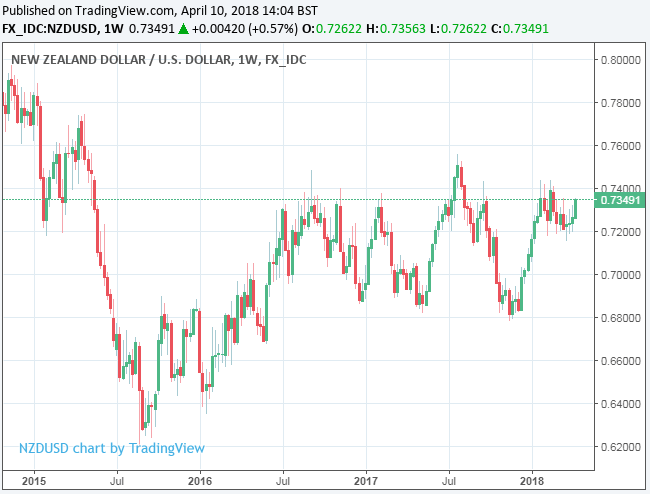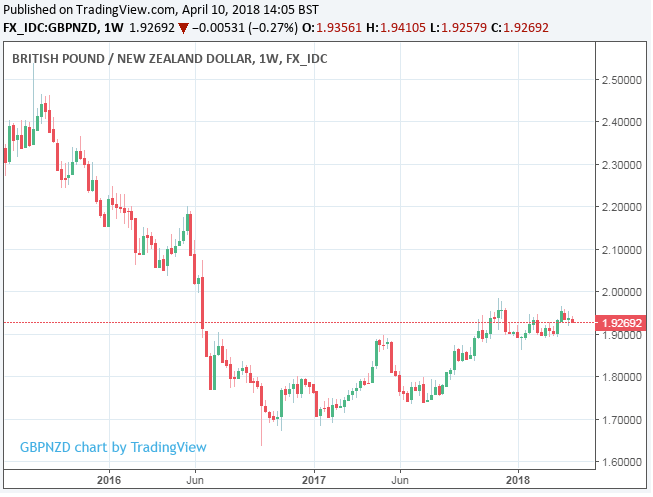NZ Dollar Bests Rivals as Risk Appetite Returns
- Written by: James Skinner
-
- NZD sweeps the board as risk appetite returns to markets.
- But technical picture suggests NZD downside around the corner.
- Some still forecast a higher NZD and lower GBP/NZD by year-end.

© Natanael Ginting, Adobe Stock
The New Zealand Dollar swept the floor with its developed world rivals during the London session Tuesday, scoring notable gains over the all of the G10 basket as markets renewed their collective appetite for risk in the wake of a conciliatory speech on global trade from President Xi Jingping.
Speaking at the annual Boao Forum for Asia conference, Xi told an audience that China will work harder to open up its economy to the rest of the world, which could include a relaxation of tariffs on car imports from the rest of the world. Most importantly, Xi pledged to strengthen legislation designed to protect intellectual property and avoided any harsh rhetoric toward the White House.
"Commodity currencies made a comeback Tuesday as global trade tensions cooled. China’s president spoke in a largely reassuring tone, saying the world’s No. 2 economy would cut tariffs in Chinese imports of automobiles. Trade-sensitive currencies from Canada, Australia and New Zealand rallied to fresh multiweek peaks," says Joe Manimbo, a foreign exchange analyst with Western Union.
Jinping's comments served to ease previously-elevated tensions over the potential for a so called trade war between the US and China. The New Zealand Dollar drew a strong boost from this given the economy's exposure to China and Kiwi's position as a commodity currency, and therefore a risk currency. Most risk currencies, just like other risk assets such as stocks, tend to do well when markets are in an upbeat mood and poorly when risk sentiment deteriorates.
"While we are still a long way from a resolution of the current trade disputes and more negative headline news is very likely to follow (with the subsequent implications for risk assets), the risk environment should remain stable today with the likes of AUD and NZD outperforming while JPY lags its G10 peers," says Petr Krpata, chief EMEA foreign exchange strategist at ING Group.
Trade concerns follow a month long period that saw President Donald Trump impose tariffs on a range of imported Chinese goods, citing alleged intellectual property theft by the state as well as generally unfair trading practices. China has since retaliated with its own round of tariffs on imports of American agricultural goods. These all followed an earlier move by the White House to impose fresh levies on imported steel and aluminium, which drew international condemnation.
"The kiwi pulling toward the high end of the range versus the greenback again – are we really going to challenge the highs for the cycle again?," asks John Hardy, chief FX strategist at Saxo Bank. "We would expect increasingly stern Reserve Bank of New Zealand observations on the currency as soon as the May 10 meeting as we await an impression of new governor Orr’s style."

Above: USD/NZD rate shown at weekly intervals.
The NZD/USD rate was quoted 0.61% higher at 0.7349 during noon trading in London Tuesday while the Pound-to-Kiwi rate was 0.29% lower at 1.9286. New Zealand's Dollar also scored noteworthy gains over the low-yielding Japanese Yen and the Norwegian Krone, rising 0.94% and 0.93% respectively.

Above: Pound-to-Kiwi rate at weekly intervals.
"The Kiwi rate has been bid up into the early week, getting help from conciliatory trade talk out from the US and China. At the same time, this should also keep the Fed thinking about adding a fourth rate hike this year, with yield differentials favouring the US Dollar. We would also highlight less than stellar economic data out of New Zealand in recent weeks," says Joel Kruger, head of FX strategy at LMAX Exchange.
Kruger touches on the most critical issue for the New Zealand Dollar at present, which is an emerging gap between Kiwi and US interest rates that now favours the US Dollar. Both countries have their interest rates set at 1.75% although the Federal Reserve is expected to carry on raising rates over the coming quarters, with markets looking for at least another two 25 basis point hikes to come inside the 2018 year alone.
Developments on this front will be key to determining the trajectory for the New Zealand Dollar because the yield shift means international investors may now shun New Zealand bonds in favour of their North American counterparts, undermining a key driver of demand for the Kiwi currency in the quarters ahead.
Only a change in Reserve Bank of New Zealand monetary policy can prevent this from weighing on the Kiwi Dollar over the medium term, which appears unlikely given the bank remains hamstrung by a series of government-led reforms to its mandate and operating practices. It also has a new governor, Adrian Orr, who assumed the helm at the end of March. Very little is currently known about his policy views.
"The market looks to be in the process of topping out, with the daily chart slowly rolling over in 2018. Rallies are now expected to be very well capped below 0.7400, with only a break back above the figure to negate," Kruger warns, referring to the NZD/USD rate. "Look for deeper setbacks in the sessions ahead, with a break back below 0.7154 to strengthen the outlook and accelerate declines towards 0.7000."

Above: LMAX Exchange chart showing NZD/USD rate in 2018.
Kruger clearly has a bearish view on the New Zealand Dollar and may be justified in doing so as markets, in general, have become more pessimistic in their outlook for Reserve Bank of New Zealand monetary policy this year.
This is illustrated by pricing in interest rate derivatives markets, which currently implies the RBNZ will not lift its cash rate from the current 1.75% threshold until June 2019. Just three months ago, traders in those same markets were betting a rate hike would come by February 2019 at the latest.
Conversely, by the time June 2019 comes around, the Federal Funds rate in the US is expected to sit at 2.5%. Put simply, this means markets are betting US rates will be 0.5% higher than their Kiwi counterparts in the summer of 2019, which could have negative implications for the New Zealand Dollar over the coming quarters. Although that being said, not everybody has a pessimistic view on the Kiwi Dollar or its economy.
"NZD/USD has scope to edge modestly higher for the following four reasons," says Elias Haddad, a senior foreign exchange strategist at Commonwealth Bank of Australia:
(i) The modest depreciation in the USD;
(ii) Dairy prices will remain firm given signs of improving global momentum, underpinning the historically high New Zealand terms of trade;
(iii) Interest rate markets continue to price the next move by the RBNZ as an interest rate increase despite softer inflation;
(iv) Demand for New Zealand dollar assets remains extremely strong as global central banks and other real money managers continue to increase their exposure to New Zealand dollar portfolio assets."
Haddad and the Commonwealth team forecast the NZD/USD rate will rise toward the 0.7500 level in time for year end and that this, combined with broad stability in the Pound-to-Dollar rate, will push the Pound-to-Kiwi rate lower by around 2% ti 1.8933 before 2018 comes to a close.
Advertisement
Get up to 5% more foreign exchange by using a specialist provider to get closer to the real market rate and avoid the gaping spreads charged by your bank when providing currency. Learn more here.




